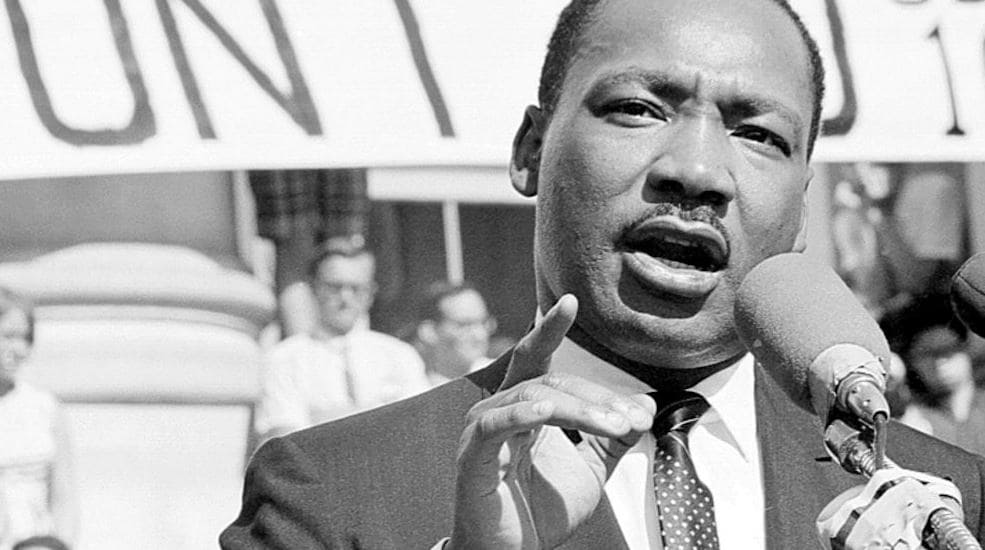Introduction
Martin Luther King Jr.’s famous address “I Have a Dream” is one of the most iconic and inspirational speeches. Notably, King spurred not only the Blacks and minorities but also the U.S. Congress to adopt civil rights for all people. Moreover, the speech is a masterpiece filled with metaphors aimed at driving points intended to foster change. In his speech “I Have a Dream,” King uses persuasive rhetorical devices, such as logos, ethos, and pathos, to inspire people for a positive change in society through metaphors of 100 years of suffering, failed promises, and Negro lives.
Logos and 100 Years of Suffering
King uses different rhetorical appeals to persuade the congregation by combining logical statistics to make his arguments. King states, “One hundred years later the life of the Negro is still badly crippled by the manacles of segregation and the chains of discrimination.”1 Through this metaphor of 100 years of suffering, the speaker supports his argument with statistics that ascertain the presence of suffering that should be fought. King also considers the quest for freedom and justice a battle that should continue until success is achieved.2 During the speech, he provides information about the current state of America and the struggles that many individuals face. Hence, Kings uses logos with a metaphor of 100 years of suffering to underline the need for freedom and equality by understanding the problem.
1. Martin Luther King Jr., “I Have a Dream.” The Gilder Lehrman Institute of American History, (2014): 1, https://www.gilderlehrman.org/sites/default/files/inline-pdfs/king.dreamspeech.excerpts.pdf.
2. Katerina Gkalitsiou and Dimosthenis Kotsopoulos, “When the Going Gets Tough, Leaders Use Metaphors and Storytelling: A Qualitative and Quantitative Study on Communication in the Context of COVID-19 and Ukraine Crises.” Administrative Sciences 13, no. 4 (2023): 4. https://doi.org/10.3390/admsci13040110.

Ethos and Failed Promises
King establishes ethical credibility throughout the speech by offering tribute to the American Foundation’s forbears. King explains, “This note was a promise that all men—yes, black men as well as white men—would be guaranteed the unalienable rights of life, liberty and the pursuit of happiness.”3 In a critical response essay, he metaphorically announces to the audience that, unless the leaders fulfill the promises, suffering Americans may not enjoy the promised freedom. King ensured that people could hold their leaders accountable since documents proclaiming their rights were available.4 He calls upon the leaders to denounce hostilities and ensure equality in all states. As a result, King’s use of ethos, including a metaphor for failed promises, reinforces the need for leadership to foster good governance.
3. King, “I Have a Dream,” 1.
4. Zakaria Zakaria, Muh Hasyim, and Syarifuddin Tundreng, “The Myth of Metaphor Symbols in Speech I Have a Dream. English Review: Journal of English Education 10, no. 3 (2022): 1035, http://doi.org/10.25134/erjee.v10i3.6702.
Pathos and Negro Lives
King uses pathos by offering an emotional perspective about the unattained American dream that everyone was expected to achieve. King deals with emotions by stating that “One hundred years later the Negro lives on a lonely island of poverty in the midst of a vast ocean of material prosperity.”5 King uses a metaphor of Negro lives to show the audience the struggles faced by the people of color, while he is part of them. In civil discourse, the speaker should focus on connecting with the audience’s emotional side because it is crucial to the argument.6 It is interesting how King depicted situations and conditions that illustrated the differences in social conditions. Therefore, King’s pathos and metaphor of Negro lives encourage Americans to seek justice and freedom through demonstrations.
5. King, 1.
6. Braj Mohan, “Understanding King’s Rhetoric: An Analysis of “I Have a Dream.” Creative Saplings 1, no. 6 (2022): 56, https://creativesaplings.in/index.php/1/article/view/154/296.
Conclusion
King’s speech “I Have a Dream” delivered a strong message that the leaders in American politics could not ignore. Combining content and vigor to discredit a discriminating system, a civil rights leader was crucial to conveying that freedom was needed. Ultimately, King effectively uses logos, ethos, and pathos with metaphors, such as 100 years of people’s suffering, failed promises made by the leaders, and Negro lives experiencing poverty, to express his arguments for racial segregation and inequality.
Bibliography
Gkalitsiou, Katerina, and Dimosthenis Kotsopoulos. “When the Going Gets Tough, Leaders Use Metaphors and Storytelling: A Qualitative and Quantitative Study on Communication in the Context of COVID-19 and Ukraine Crises.” Administrative Sciences 13, no. 4 (2023): 1-42. https://doi.org/10.3390/admsci13040110.
King, Martin Luther Jr. “I Have a Dream.” The Gilder Lehrman Institute of American History, (2014): 1-2. https://www.gilderlehrman.org/sites/default/files/inline-pdfs/king.dreamspeech.excerpts.pdf.
Mohan, Braj. “Understanding King’s Rhetoric: An Analysis of “I Have a Dream.” Creative Saplings 1, no. 6 (2022): 55-68. https://creativesaplings.in/index.php/1/article/view/154/296.
Zakaria, Zakaria, Muh Hasyim, and Syarifuddin Tundreng. “The Myth of Metaphor Symbols in Speech I Have a Dream. English Review: Journal of English Education 10, no. 3 (2022): 1035-1044. http://doi.org/10.25134/erjee.v10i3.6702.


